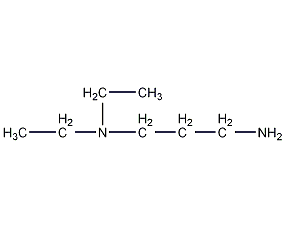
Structural formula
| Business number | 02QM |
|---|---|
| Molecular formula | C7H18N2 |
| Molecular weight | 130.23 |
| label |
Diethylaminopropylamine, Diethylaminopropane, N,N-diethyl-1,3-diaminopropane, 3-diethylaminopropylamine, Diethylamino propylamine, N,N-Diethyl-1,3-diaminopropane, 3-Diethylamino propylamine, curing agent for epoxy resin, Nitrogen-containing compound solvents, Extracting agent |
Numbering system
CAS number:104-78-9
MDL number:MFCD00008218
EINECS number:203-236-4
RTECS number:TX7350000
BRN number:741879
PubChem number:24894238
Physical property data
1. Properties: colorless liquid with fishy smell.
2. Density (g/mL, 20℃): 0.82
3. Relative vapor density (g/mL, air=1): 4.4
4. Melting point (ºC): -60
5. Boiling point (ºC, normal pressure): 164~168
6. Freezing point (ºC): -100
7. Refractive index (20ºC): 1.4416
8. Flash point (ºC): 58
9. Vapor pressure (mmHg, 70ºC): 19.5
10. Solubility: Miscible with water.
Toxicological data
1. Skin/eye irritation: Start irritation test: rabbit skin contact, 100μg/24H
2. Acute toxicity: rat oral LD50: 1410mg/kg; rabbit skin contact LD50: 750μL /kg
Ecological data
This substance is harmful to the environment, and special attention should be paid to the pollution of water bodies.
Molecular structure data
1. Molar refractive index: 41.73
2. Molar volume (cm3/mol): 155.0
3. Isotonic specific volume (90.2K): 365.3
4. Surface tension (dyne/cm): 30.8
5. Dielectric constant: 2.27
6. Dipole moment (10-24cm3):
7. Polarizability: 16.54
Compute chemical data
1. Reference value for hydrophobic parameter calculation (XlogP): 0.4
2. Number of hydrogen bond donors: 1
3. Number of hydrogen bond acceptors: 2
4. Number of rotatable chemical bonds: 5
5. Number of tautomers: none
6. Topological molecule polar surface area 29.3
7. Number of heavy atoms: 9
8. Surface charge: 0
9. Complexity: 50.9
10. Number of isotope atoms: 0
11. Determine the number of atomic stereocenters: 0
12. Uncertain number of atomic stereocenters: 0
13. Determine the number of chemical bond stereocenters: 0
14. Number of uncertain chemical bond stereocenters: 0
15. Number of covalent bond units: 1
Properties and stability
Avoid contact with strong oxidants, acids, acid chlorides, acid anhydrides, and carbon dioxide. Colorless viscous liquid. Miscible with water and has an ammonia smell. It is flammable in case of open flame, high temperature and strong oxidant. Highly toxic.
Storage method
Store in a cool, ventilated warehouse. Keep away from fire and heat sources. Protect from direct sunlight. Keep container tightly sealed. They should be stored separately from oxidants, acids, acid chlorides, acid anhydrides and carbon dioxide, and avoid mixed storage. Use explosion-proof lighting and ventilation facilities. It is prohibited to use mechanical equipment and tools that are prone to sparks. The storage area should be equipped with emergency release equipment and suitable containment materials.
Synthesis method
It is obtained by the addition of acrylonitrile and diethylamine and then reduction. Add diethylamine into the reaction kettle, cool to 0°C, start stirring and add acrylonitrile dropwise, and the temperature will gradually increase to 7°C automatically. After adding acrylonitrile, raise the temperature to 45°C, continue stirring the reaction for 2 hours, and leave it overnight. Distill under reduced pressure to obtain diethylaminopropionitrile. Add diethylaminopropionitrile, reaction medium methanolamine saturated solution and catalyst skeleton nickel into the autoclave, introduce hydrogen gas to carry out hydrogenation reduction reaction, and the reaction temperature rises to 100°C until the reaction system no longer absorbs hydrogen. Then it is cooled and placed, and the catalyst is recovered by filtration. The filtrate is added to a distillation device to evaporate the methanol and then is fractionated to obtain the finished product. ![]()

Purpose
Since the molecule of this product contains two active hydrogens and a tertiary amine group that promotes the curing reaction of epoxy resin, it can be used as a curing agent for epoxy resin. This product cures slowly and has a long service life. It is suitable for small castings, laminates and adhesives. The dosage is 6 to 12 parts, and the curing conditions are 60℃/4h+120℃/1h. This product has low viscosity and is easy to use. Products cured with this product have good electrical properties and low-temperature characteristics, with a heat distortion temperature of about 100°C. This product is also used as solvent, extraction agent and organic synthesis intermediate.


